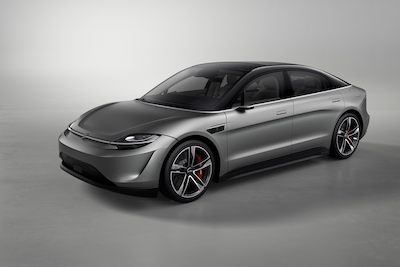The maker of PlayStation and inventor of Betamax video introduced a rolling chassis developed jointly with Magna that showcased safety and interior technology.
February 13, 2020

While some were surprised by the entry of Japanese consumer electronics firm Sony into the electric vehicle field at the recent Consumer Electronics Show (CES) in Las Vegas, maybe we shouldn’t be so surprised. After all, Apple and Google are dabbling in the field and even UK vacuum cleaner Dyson mooted an EV project but pulled the plug in the end. And looking at recent developments in China, Sony’s foray could be a harbinger of things to come.
|
The Vision-S also highlights Sony's screen offering for autos, including a panoramic widescreen that spans the entire dash. Image courtesy of Sony. |
Most notably, Sony teamed up with Canada’s Magna to develop the chassis for the Sony Vision-S EV. Magna’s capabilities include the design, engineering, testing and manufacture of body & chassis systems, and hybrid to electric vehicle systems, to name a few. With this degree of cooperation, Magna might well alienate itself from its major OEM customers if the current project proceeds to fruition.
The Sony Vision-S uses two 268-hp electric motors that can accelerate the car from 0–60 mph in 4.8 seconds.
The Sony Vision-S concept is a rolling chassis for technology—at least for now. Sony is using the sedan to showcase various safety and interior technologies. The Vision-S concept uses 33 sensors including 12 cameras, three solid-state lidar sensors, and an array of nearly 20 radar and ultrasonic sensors to keep the car safe. In addition to active lane control, Sony said the hardware on the Vision-S car would be capable of Level 2 driver-assistance and could be upgraded to Level 4 semi-autonomy through software updates. The exterior cameras can also be used to recognize drivers and passengers as they approach the car.
The Vision-S also highlights Sony's screen offering for autos, including a panoramic widescreen that spans the entire dash. The screen has a separate driver information cluster, center infotainment screen, and passenger-side screen controlled via a jog wheel. At both ends, a screen displays side-view cameras in place of mirrors. The rear seats offer two additional screens mounted on the front-seat headrests.
Sony’s role as a pioneer in audio equipment sees it emphasize the acoustic capabilities of the Vision-S’ sound system. Equipped with more than 30 speakers inside, including pairs of seat-mounted speakers under the headrests, the system can create 3D audio that can be used with the widescreen system.
About the Author(s)
You May Also Like





